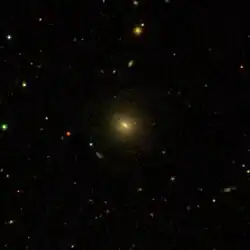| NGC 462 | |
|---|---|
 NGC 462 as seen on SDSS | |
| Observation data (J2000[1] epoch) | |
| Constellation | Pisces |
| Right ascension | 01h 18m 10.9s[2] |
| Declination | +04° 13′ 35″[2] |
| Redshift | 0.04650 ± 0.00010[1] |
| Heliocentric radial velocity | 13615 ± 29 km/s[1] |
| Distance | 623 Mly[3] |
| Apparent magnitude (V) | 14,7 |
| Characteristics | |
| Type | Elliptical |
| Apparent size (V) | 0,4' × 0,4' |
| Other designations | |
| PGC 4667, GC 5162, NPM1G +03.0047[4] | |
NGC 462 is an elliptical galaxy located in the Pisces constellation. It was discovered by Albert Marth on 23 October 1864. Dreyer, creator of the New General Catalogue, originally described it as "extremely faint, very small, stellar". The word stellar clearly suggests an initial misidentification of NGC 462 as a star.[4]
See also

NGC 462 (2MASS)
References
- 1 2 3 "NGC 462". SIMBAD. Retrieved 7 August 2014.
- 1 2 "NGC 462". spider.seds.org. Retrieved 7 August 2014.
- ↑ An object's distance from Earth can be determined using Hubble's law: v=Ho is Hubble's constant (70±5 (km/s)/Mpc). The relative uncertainty Δd/d divided by the distance is equal to the sum of the relative uncertainties of the velocity and v=Ho
- 1 2 "New General Catalog Objects: NGC 450 - 499". cseligman.com. Retrieved 2017-12-08.
External links
 Media related to NGC 462 at Wikimedia Commons
Media related to NGC 462 at Wikimedia Commons- NGC 462 on WikiSky: DSS2, SDSS, GALEX, IRAS, Hydrogen α, X-Ray, Astrophoto, Sky Map, Articles and images
- SEDS
This article is issued from Wikipedia. The text is licensed under Creative Commons - Attribution - Sharealike. Additional terms may apply for the media files.